Management Accounting Analysis and Report: Nisa Ltd, UK SME
VerifiedAdded on 2020/01/23
|24
|5909
|110
Report
AI Summary
This report examines the application of management accounting principles within Nisa Ltd, a small to medium-sized enterprise (SME) in the UK retail sector. The report explores the significance of management accounting systems, including job order costing, cost accounting, inventory management, and risk management, in enhancing business operations and decision-making. It details various techniques used for management accounting reporting, such as job cost reports, inventory management reports, and performance reports, highlighting their role in financial analysis and strategic planning. Furthermore, the report delves into costing techniques for preparing income statements, specifically marginal costing, providing insights into price determination and profit analysis. The analysis underscores the importance of management accounting tools in facilitating business growth, improving efficiency, and ensuring effective resource allocation within the organization. The report emphasizes the role of management accounting in decision making and action planning for expansion of small scale firm.
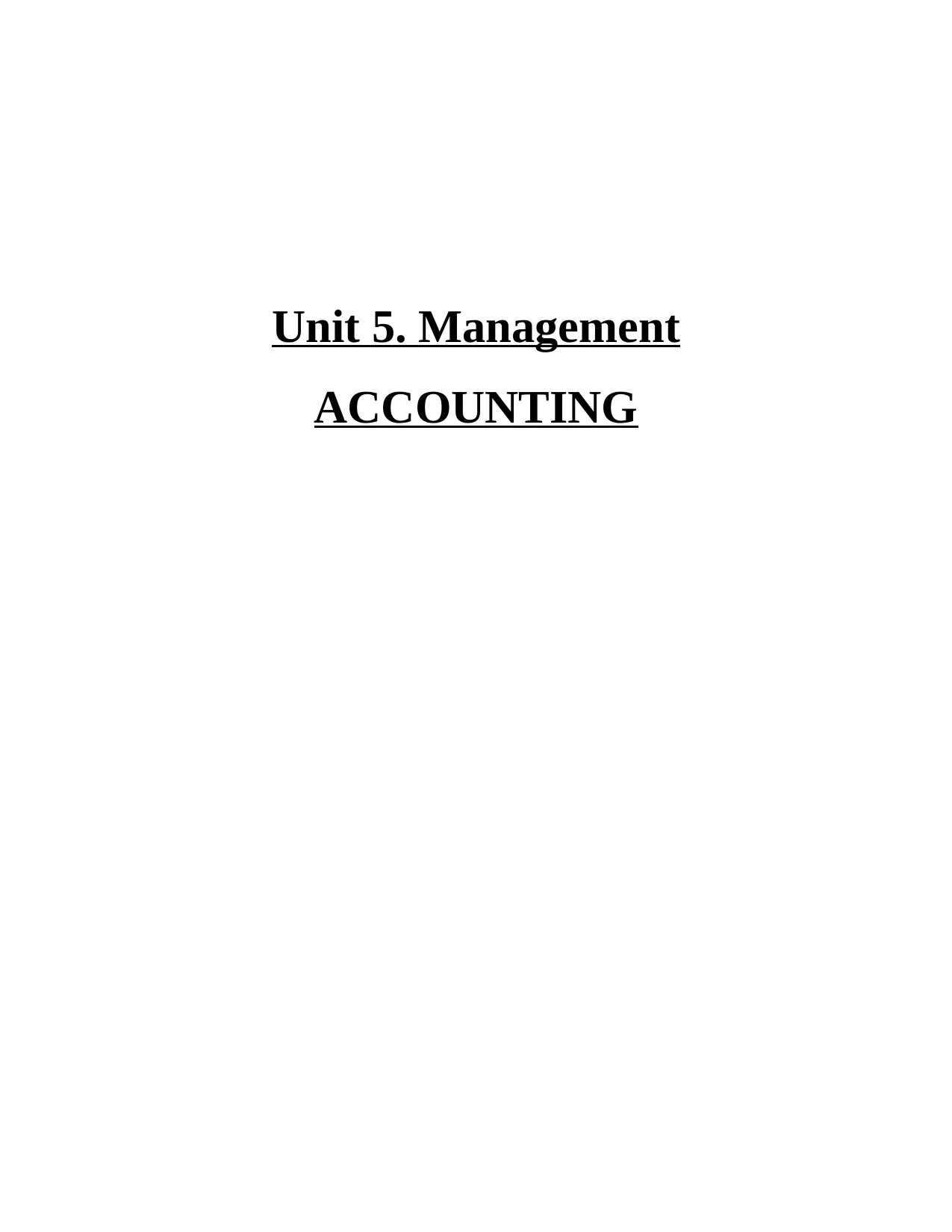
Unit 5. Management
ACCOUNTING
ACCOUNTING
Paraphrase This Document
Need a fresh take? Get an instant paraphrase of this document with our AI Paraphraser
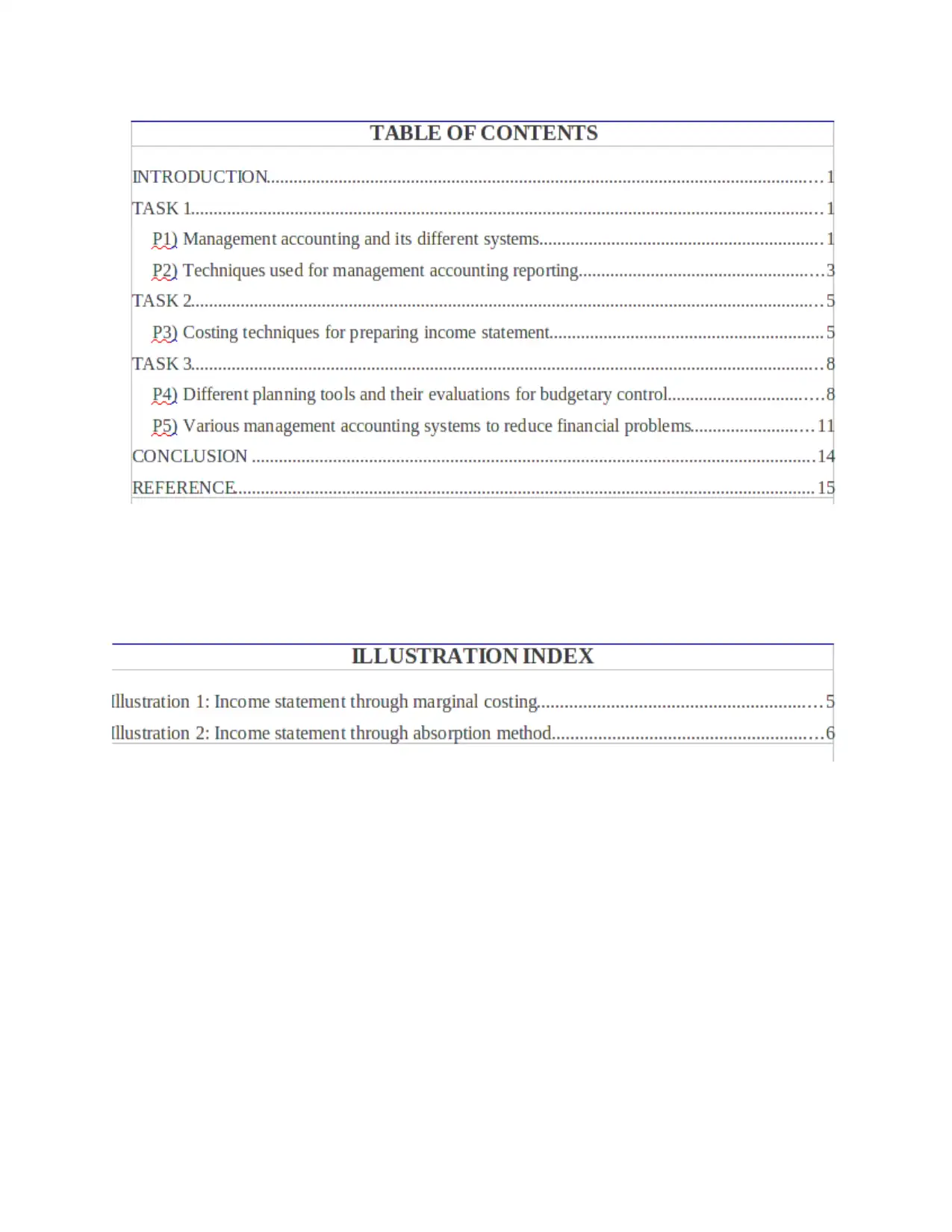
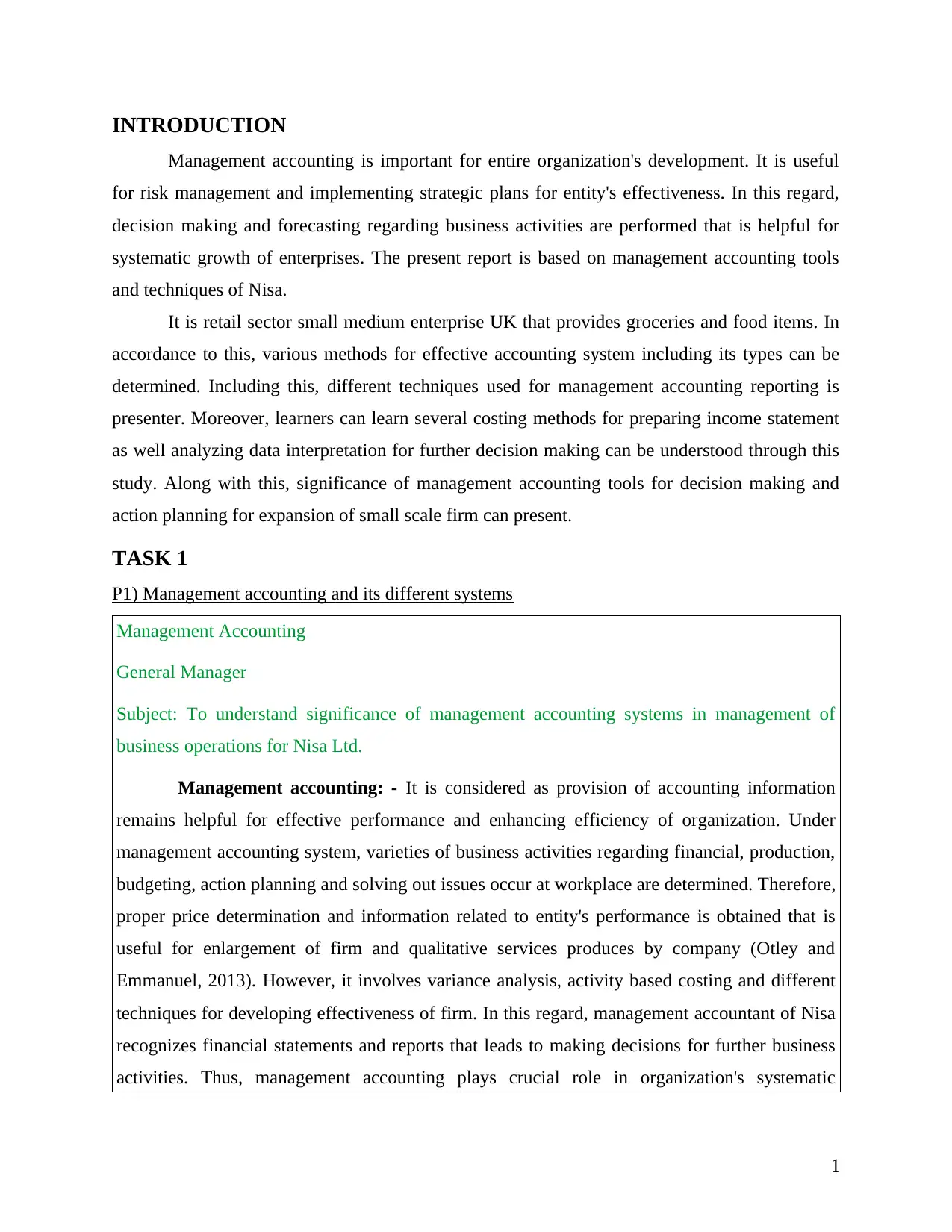
INTRODUCTION
Management accounting is important for entire organization's development. It is useful
for risk management and implementing strategic plans for entity's effectiveness. In this regard,
decision making and forecasting regarding business activities are performed that is helpful for
systematic growth of enterprises. The present report is based on management accounting tools
and techniques of Nisa.
It is retail sector small medium enterprise UK that provides groceries and food items. In
accordance to this, various methods for effective accounting system including its types can be
determined. Including this, different techniques used for management accounting reporting is
presenter. Moreover, learners can learn several costing methods for preparing income statement
as well analyzing data interpretation for further decision making can be understood through this
study. Along with this, significance of management accounting tools for decision making and
action planning for expansion of small scale firm can present.
TASK 1
P1) Management accounting and its different systems
Management Accounting
General Manager
Subject: To understand significance of management accounting systems in management of
business operations for Nisa Ltd.
Management accounting: - It is considered as provision of accounting information
remains helpful for effective performance and enhancing efficiency of organization. Under
management accounting system, varieties of business activities regarding financial, production,
budgeting, action planning and solving out issues occur at workplace are determined. Therefore,
proper price determination and information related to entity's performance is obtained that is
useful for enlargement of firm and qualitative services produces by company (Otley and
Emmanuel, 2013). However, it involves variance analysis, activity based costing and different
techniques for developing effectiveness of firm. In this regard, management accountant of Nisa
recognizes financial statements and reports that leads to making decisions for further business
activities. Thus, management accounting plays crucial role in organization's systematic
1
Management accounting is important for entire organization's development. It is useful
for risk management and implementing strategic plans for entity's effectiveness. In this regard,
decision making and forecasting regarding business activities are performed that is helpful for
systematic growth of enterprises. The present report is based on management accounting tools
and techniques of Nisa.
It is retail sector small medium enterprise UK that provides groceries and food items. In
accordance to this, various methods for effective accounting system including its types can be
determined. Including this, different techniques used for management accounting reporting is
presenter. Moreover, learners can learn several costing methods for preparing income statement
as well analyzing data interpretation for further decision making can be understood through this
study. Along with this, significance of management accounting tools for decision making and
action planning for expansion of small scale firm can present.
TASK 1
P1) Management accounting and its different systems
Management Accounting
General Manager
Subject: To understand significance of management accounting systems in management of
business operations for Nisa Ltd.
Management accounting: - It is considered as provision of accounting information
remains helpful for effective performance and enhancing efficiency of organization. Under
management accounting system, varieties of business activities regarding financial, production,
budgeting, action planning and solving out issues occur at workplace are determined. Therefore,
proper price determination and information related to entity's performance is obtained that is
useful for enlargement of firm and qualitative services produces by company (Otley and
Emmanuel, 2013). However, it involves variance analysis, activity based costing and different
techniques for developing effectiveness of firm. In this regard, management accountant of Nisa
recognizes financial statements and reports that leads to making decisions for further business
activities. Thus, management accounting plays crucial role in organization's systematic
1
⊘ This is a preview!⊘
Do you want full access?
Subscribe today to unlock all pages.

Trusted by 1+ million students worldwide
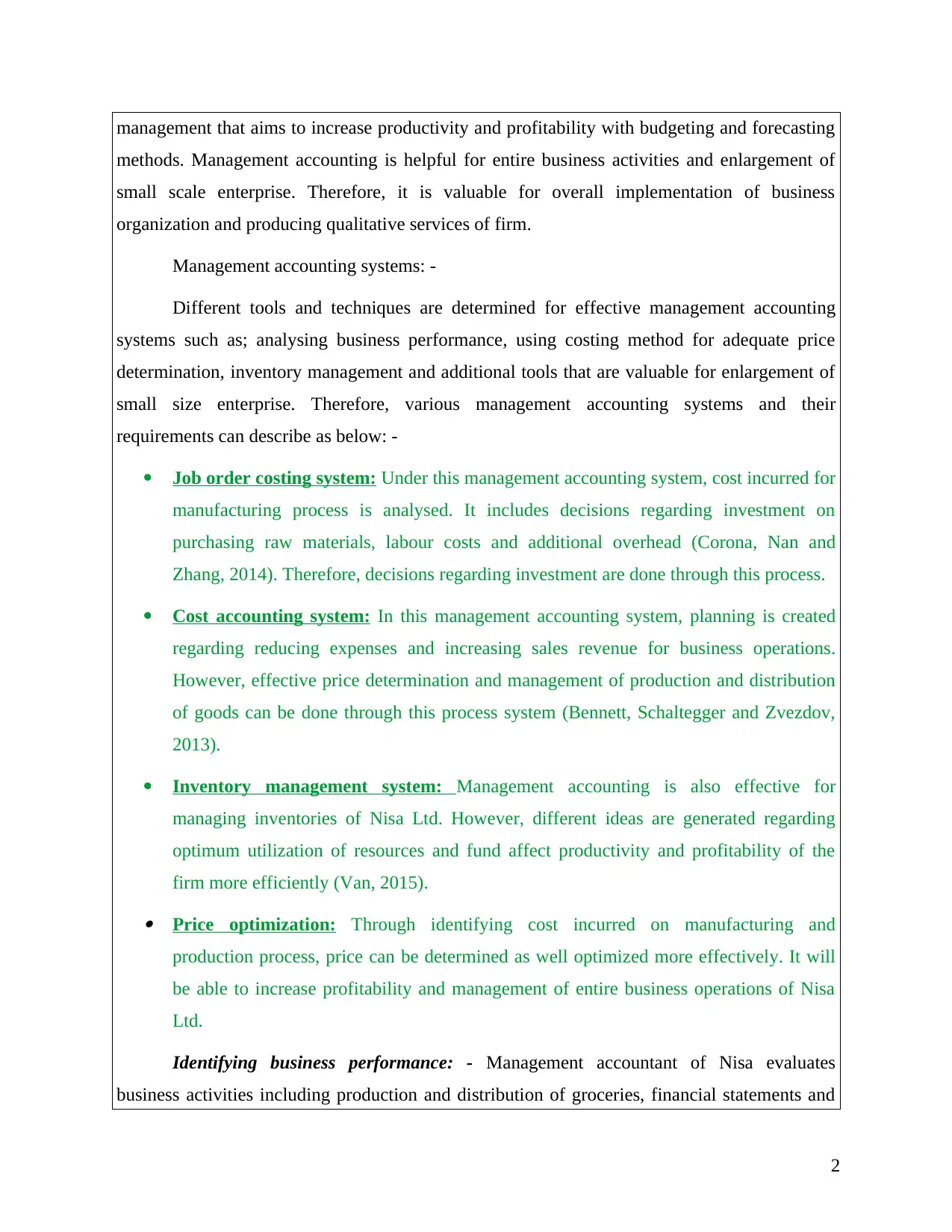
management that aims to increase productivity and profitability with budgeting and forecasting
methods. Management accounting is helpful for entire business activities and enlargement of
small scale enterprise. Therefore, it is valuable for overall implementation of business
organization and producing qualitative services of firm.
Management accounting systems: -
Different tools and techniques are determined for effective management accounting
systems such as; analysing business performance, using costing method for adequate price
determination, inventory management and additional tools that are valuable for enlargement of
small size enterprise. Therefore, various management accounting systems and their
requirements can describe as below: -
Job order costing system: Under this management accounting system, cost incurred for
manufacturing process is analysed. It includes decisions regarding investment on
purchasing raw materials, labour costs and additional overhead (Corona, Nan and
Zhang, 2014). Therefore, decisions regarding investment are done through this process.
Cost accounting system: In this management accounting system, planning is created
regarding reducing expenses and increasing sales revenue for business operations.
However, effective price determination and management of production and distribution
of goods can be done through this process system (Bennett, Schaltegger and Zvezdov,
2013).
Inventory management system: Management accounting is also effective for
managing inventories of Nisa Ltd. However, different ideas are generated regarding
optimum utilization of resources and fund affect productivity and profitability of the
firm more efficiently (Van, 2015). Price optimization: Through identifying cost incurred on manufacturing and
production process, price can be determined as well optimized more effectively. It will
be able to increase profitability and management of entire business operations of Nisa
Ltd.
Identifying business performance: - Management accountant of Nisa evaluates
business activities including production and distribution of groceries, financial statements and
2
methods. Management accounting is helpful for entire business activities and enlargement of
small scale enterprise. Therefore, it is valuable for overall implementation of business
organization and producing qualitative services of firm.
Management accounting systems: -
Different tools and techniques are determined for effective management accounting
systems such as; analysing business performance, using costing method for adequate price
determination, inventory management and additional tools that are valuable for enlargement of
small size enterprise. Therefore, various management accounting systems and their
requirements can describe as below: -
Job order costing system: Under this management accounting system, cost incurred for
manufacturing process is analysed. It includes decisions regarding investment on
purchasing raw materials, labour costs and additional overhead (Corona, Nan and
Zhang, 2014). Therefore, decisions regarding investment are done through this process.
Cost accounting system: In this management accounting system, planning is created
regarding reducing expenses and increasing sales revenue for business operations.
However, effective price determination and management of production and distribution
of goods can be done through this process system (Bennett, Schaltegger and Zvezdov,
2013).
Inventory management system: Management accounting is also effective for
managing inventories of Nisa Ltd. However, different ideas are generated regarding
optimum utilization of resources and fund affect productivity and profitability of the
firm more efficiently (Van, 2015). Price optimization: Through identifying cost incurred on manufacturing and
production process, price can be determined as well optimized more effectively. It will
be able to increase profitability and management of entire business operations of Nisa
Ltd.
Identifying business performance: - Management accountant of Nisa evaluates
business activities including production and distribution of groceries, financial statements and
2
Paraphrase This Document
Need a fresh take? Get an instant paraphrase of this document with our AI Paraphraser
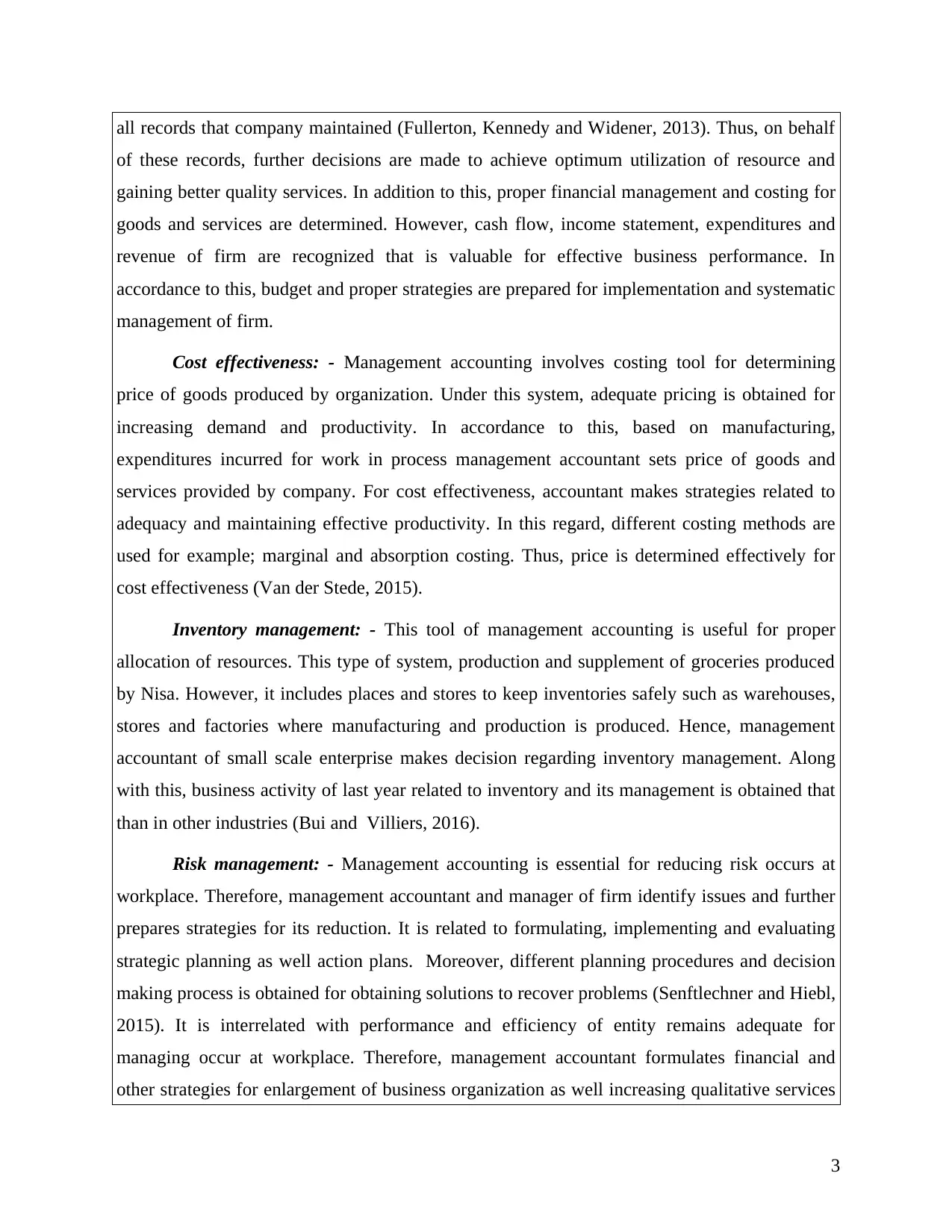
all records that company maintained (Fullerton, Kennedy and Widener, 2013). Thus, on behalf
of these records, further decisions are made to achieve optimum utilization of resource and
gaining better quality services. In addition to this, proper financial management and costing for
goods and services are determined. However, cash flow, income statement, expenditures and
revenue of firm are recognized that is valuable for effective business performance. In
accordance to this, budget and proper strategies are prepared for implementation and systematic
management of firm.
Cost effectiveness: - Management accounting involves costing tool for determining
price of goods produced by organization. Under this system, adequate pricing is obtained for
increasing demand and productivity. In accordance to this, based on manufacturing,
expenditures incurred for work in process management accountant sets price of goods and
services provided by company. For cost effectiveness, accountant makes strategies related to
adequacy and maintaining effective productivity. In this regard, different costing methods are
used for example; marginal and absorption costing. Thus, price is determined effectively for
cost effectiveness (Van der Stede, 2015).
Inventory management: - This tool of management accounting is useful for proper
allocation of resources. This type of system, production and supplement of groceries produced
by Nisa. However, it includes places and stores to keep inventories safely such as warehouses,
stores and factories where manufacturing and production is produced. Hence, management
accountant of small scale enterprise makes decision regarding inventory management. Along
with this, business activity of last year related to inventory and its management is obtained that
than in other industries (Bui and Villiers, 2016).
Risk management: - Management accounting is essential for reducing risk occurs at
workplace. Therefore, management accountant and manager of firm identify issues and further
prepares strategies for its reduction. It is related to formulating, implementing and evaluating
strategic planning as well action plans. Moreover, different planning procedures and decision
making process is obtained for obtaining solutions to recover problems (Senftlechner and Hiebl,
2015). It is interrelated with performance and efficiency of entity remains adequate for
managing occur at workplace. Therefore, management accountant formulates financial and
other strategies for enlargement of business organization as well increasing qualitative services
3
of these records, further decisions are made to achieve optimum utilization of resource and
gaining better quality services. In addition to this, proper financial management and costing for
goods and services are determined. However, cash flow, income statement, expenditures and
revenue of firm are recognized that is valuable for effective business performance. In
accordance to this, budget and proper strategies are prepared for implementation and systematic
management of firm.
Cost effectiveness: - Management accounting involves costing tool for determining
price of goods produced by organization. Under this system, adequate pricing is obtained for
increasing demand and productivity. In accordance to this, based on manufacturing,
expenditures incurred for work in process management accountant sets price of goods and
services provided by company. For cost effectiveness, accountant makes strategies related to
adequacy and maintaining effective productivity. In this regard, different costing methods are
used for example; marginal and absorption costing. Thus, price is determined effectively for
cost effectiveness (Van der Stede, 2015).
Inventory management: - This tool of management accounting is useful for proper
allocation of resources. This type of system, production and supplement of groceries produced
by Nisa. However, it includes places and stores to keep inventories safely such as warehouses,
stores and factories where manufacturing and production is produced. Hence, management
accountant of small scale enterprise makes decision regarding inventory management. Along
with this, business activity of last year related to inventory and its management is obtained that
than in other industries (Bui and Villiers, 2016).
Risk management: - Management accounting is essential for reducing risk occurs at
workplace. Therefore, management accountant and manager of firm identify issues and further
prepares strategies for its reduction. It is related to formulating, implementing and evaluating
strategic planning as well action plans. Moreover, different planning procedures and decision
making process is obtained for obtaining solutions to recover problems (Senftlechner and Hiebl,
2015). It is interrelated with performance and efficiency of entity remains adequate for
managing occur at workplace. Therefore, management accountant formulates financial and
other strategies for enlargement of business organization as well increasing qualitative services
3
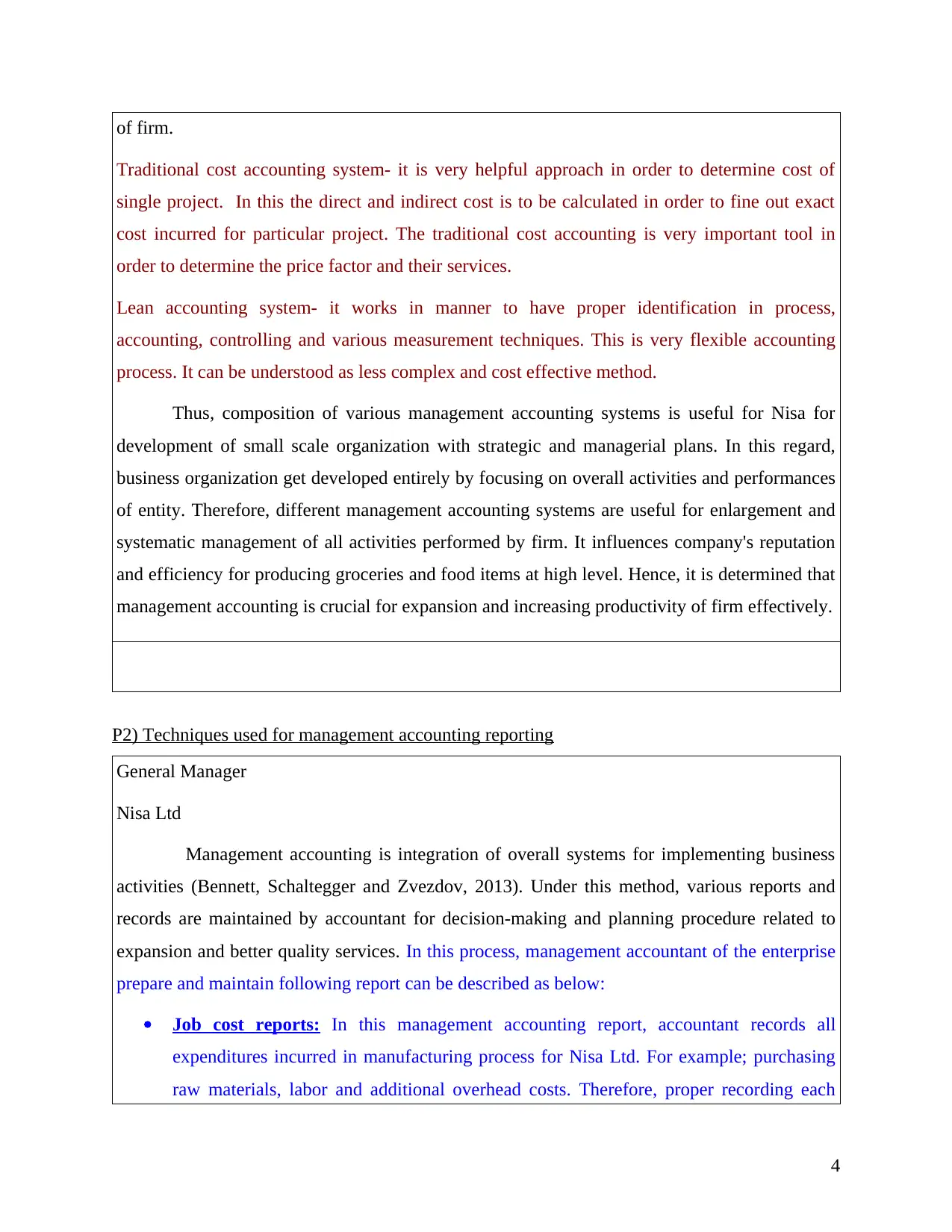
of firm.
Traditional cost accounting system- it is very helpful approach in order to determine cost of
single project. In this the direct and indirect cost is to be calculated in order to fine out exact
cost incurred for particular project. The traditional cost accounting is very important tool in
order to determine the price factor and their services.
Lean accounting system- it works in manner to have proper identification in process,
accounting, controlling and various measurement techniques. This is very flexible accounting
process. It can be understood as less complex and cost effective method.
Thus, composition of various management accounting systems is useful for Nisa for
development of small scale organization with strategic and managerial plans. In this regard,
business organization get developed entirely by focusing on overall activities and performances
of entity. Therefore, different management accounting systems are useful for enlargement and
systematic management of all activities performed by firm. It influences company's reputation
and efficiency for producing groceries and food items at high level. Hence, it is determined that
management accounting is crucial for expansion and increasing productivity of firm effectively.
P2) Techniques used for management accounting reporting
General Manager
Nisa Ltd
Management accounting is integration of overall systems for implementing business
activities (Bennett, Schaltegger and Zvezdov, 2013). Under this method, various reports and
records are maintained by accountant for decision-making and planning procedure related to
expansion and better quality services. In this process, management accountant of the enterprise
prepare and maintain following report can be described as below:
Job cost reports: In this management accounting report, accountant records all
expenditures incurred in manufacturing process for Nisa Ltd. For example; purchasing
raw materials, labor and additional overhead costs. Therefore, proper recording each
4
Traditional cost accounting system- it is very helpful approach in order to determine cost of
single project. In this the direct and indirect cost is to be calculated in order to fine out exact
cost incurred for particular project. The traditional cost accounting is very important tool in
order to determine the price factor and their services.
Lean accounting system- it works in manner to have proper identification in process,
accounting, controlling and various measurement techniques. This is very flexible accounting
process. It can be understood as less complex and cost effective method.
Thus, composition of various management accounting systems is useful for Nisa for
development of small scale organization with strategic and managerial plans. In this regard,
business organization get developed entirely by focusing on overall activities and performances
of entity. Therefore, different management accounting systems are useful for enlargement and
systematic management of all activities performed by firm. It influences company's reputation
and efficiency for producing groceries and food items at high level. Hence, it is determined that
management accounting is crucial for expansion and increasing productivity of firm effectively.
P2) Techniques used for management accounting reporting
General Manager
Nisa Ltd
Management accounting is integration of overall systems for implementing business
activities (Bennett, Schaltegger and Zvezdov, 2013). Under this method, various reports and
records are maintained by accountant for decision-making and planning procedure related to
expansion and better quality services. In this process, management accountant of the enterprise
prepare and maintain following report can be described as below:
Job cost reports: In this management accounting report, accountant records all
expenditures incurred in manufacturing process for Nisa Ltd. For example; purchasing
raw materials, labor and additional overhead costs. Therefore, proper recording each
4
⊘ This is a preview!⊘
Do you want full access?
Subscribe today to unlock all pages.

Trusted by 1+ million students worldwide
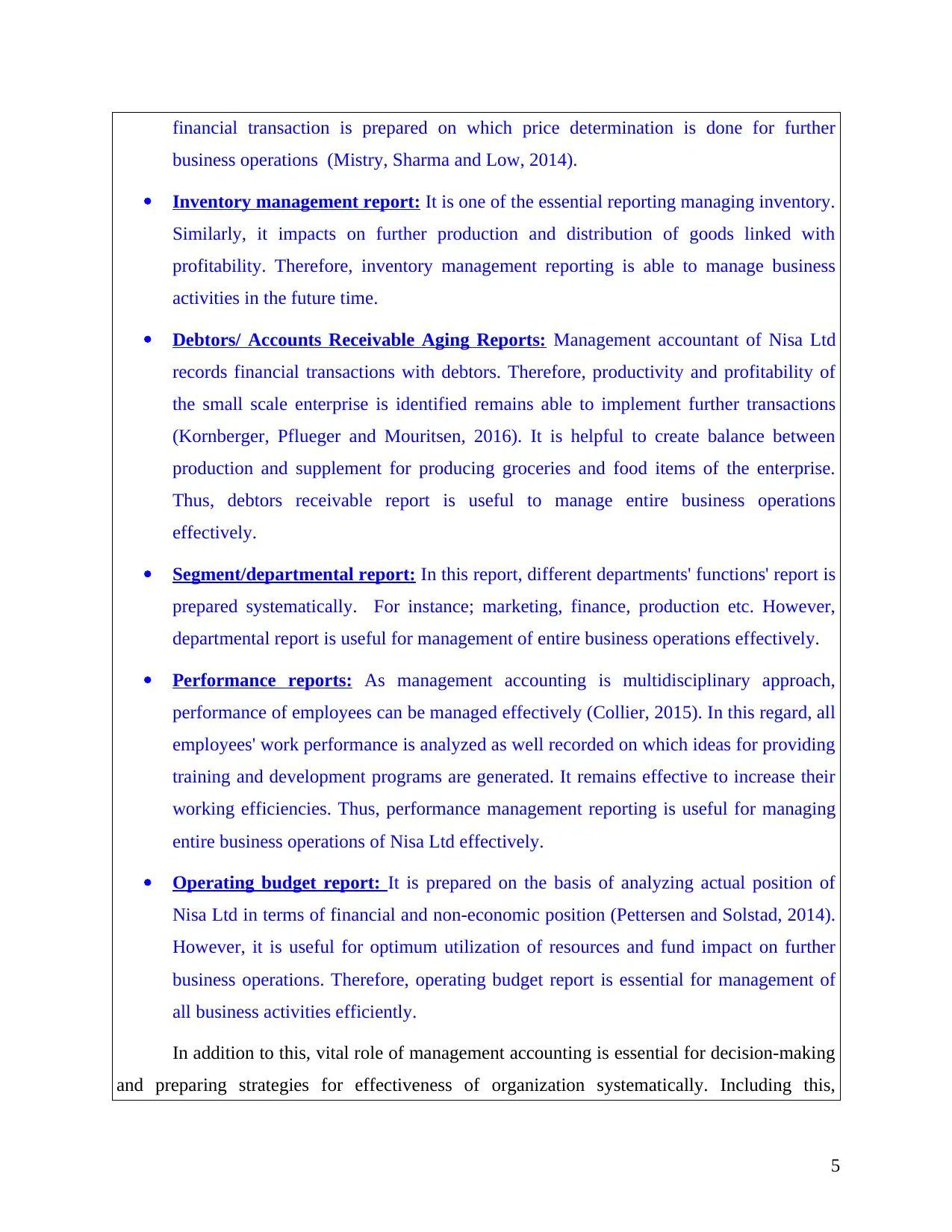
financial transaction is prepared on which price determination is done for further
business operations (Mistry, Sharma and Low, 2014).
Inventory management report: It is one of the essential reporting managing inventory.
Similarly, it impacts on further production and distribution of goods linked with
profitability. Therefore, inventory management reporting is able to manage business
activities in the future time.
Debtors/ Accounts Receivable Aging Reports: Management accountant of Nisa Ltd
records financial transactions with debtors. Therefore, productivity and profitability of
the small scale enterprise is identified remains able to implement further transactions
(Kornberger, Pflueger and Mouritsen, 2016). It is helpful to create balance between
production and supplement for producing groceries and food items of the enterprise.
Thus, debtors receivable report is useful to manage entire business operations
effectively.
Segment/departmental report: In this report, different departments' functions' report is
prepared systematically. For instance; marketing, finance, production etc. However,
departmental report is useful for management of entire business operations effectively.
Performance reports: As management accounting is multidisciplinary approach,
performance of employees can be managed effectively (Collier, 2015). In this regard, all
employees' work performance is analyzed as well recorded on which ideas for providing
training and development programs are generated. It remains effective to increase their
working efficiencies. Thus, performance management reporting is useful for managing
entire business operations of Nisa Ltd effectively.
Operating budget report: It is prepared on the basis of analyzing actual position of
Nisa Ltd in terms of financial and non-economic position (Pettersen and Solstad, 2014).
However, it is useful for optimum utilization of resources and fund impact on further
business operations. Therefore, operating budget report is essential for management of
all business activities efficiently.
In addition to this, vital role of management accounting is essential for decision-making
and preparing strategies for effectiveness of organization systematically. Including this,
5
business operations (Mistry, Sharma and Low, 2014).
Inventory management report: It is one of the essential reporting managing inventory.
Similarly, it impacts on further production and distribution of goods linked with
profitability. Therefore, inventory management reporting is able to manage business
activities in the future time.
Debtors/ Accounts Receivable Aging Reports: Management accountant of Nisa Ltd
records financial transactions with debtors. Therefore, productivity and profitability of
the small scale enterprise is identified remains able to implement further transactions
(Kornberger, Pflueger and Mouritsen, 2016). It is helpful to create balance between
production and supplement for producing groceries and food items of the enterprise.
Thus, debtors receivable report is useful to manage entire business operations
effectively.
Segment/departmental report: In this report, different departments' functions' report is
prepared systematically. For instance; marketing, finance, production etc. However,
departmental report is useful for management of entire business operations effectively.
Performance reports: As management accounting is multidisciplinary approach,
performance of employees can be managed effectively (Collier, 2015). In this regard, all
employees' work performance is analyzed as well recorded on which ideas for providing
training and development programs are generated. It remains effective to increase their
working efficiencies. Thus, performance management reporting is useful for managing
entire business operations of Nisa Ltd effectively.
Operating budget report: It is prepared on the basis of analyzing actual position of
Nisa Ltd in terms of financial and non-economic position (Pettersen and Solstad, 2014).
However, it is useful for optimum utilization of resources and fund impact on further
business operations. Therefore, operating budget report is essential for management of
all business activities efficiently.
In addition to this, vital role of management accounting is essential for decision-making
and preparing strategies for effectiveness of organization systematically. Including this,
5
Paraphrase This Document
Need a fresh take? Get an instant paraphrase of this document with our AI Paraphraser
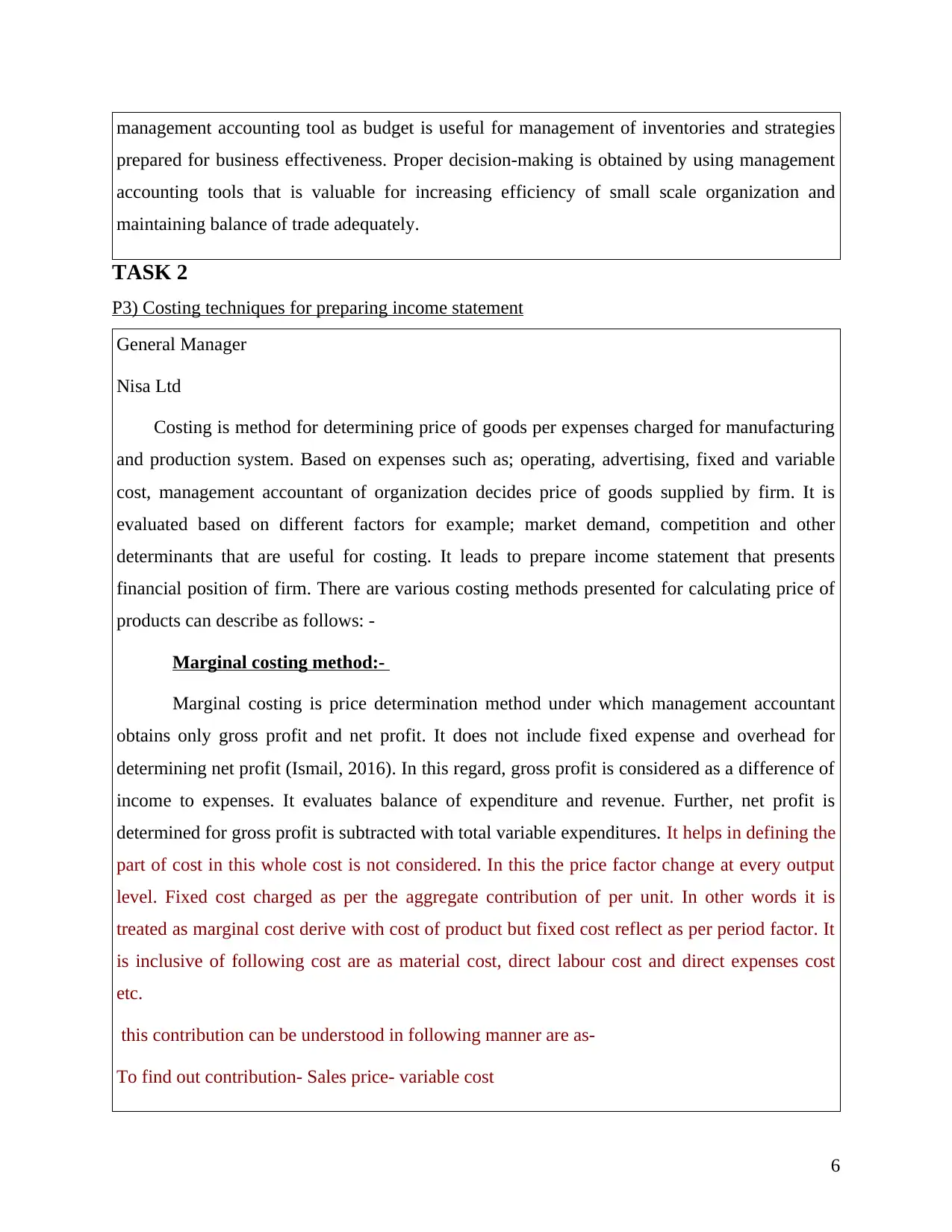
management accounting tool as budget is useful for management of inventories and strategies
prepared for business effectiveness. Proper decision-making is obtained by using management
accounting tools that is valuable for increasing efficiency of small scale organization and
maintaining balance of trade adequately.
TASK 2
P3) Costing techniques for preparing income statement
General Manager
Nisa Ltd
Costing is method for determining price of goods per expenses charged for manufacturing
and production system. Based on expenses such as; operating, advertising, fixed and variable
cost, management accountant of organization decides price of goods supplied by firm. It is
evaluated based on different factors for example; market demand, competition and other
determinants that are useful for costing. It leads to prepare income statement that presents
financial position of firm. There are various costing methods presented for calculating price of
products can describe as follows: -
Marginal costing method:-
Marginal costing is price determination method under which management accountant
obtains only gross profit and net profit. It does not include fixed expense and overhead for
determining net profit (Ismail, 2016). In this regard, gross profit is considered as a difference of
income to expenses. It evaluates balance of expenditure and revenue. Further, net profit is
determined for gross profit is subtracted with total variable expenditures. It helps in defining the
part of cost in this whole cost is not considered. In this the price factor change at every output
level. Fixed cost charged as per the aggregate contribution of per unit. In other words it is
treated as marginal cost derive with cost of product but fixed cost reflect as per period factor. It
is inclusive of following cost are as material cost, direct labour cost and direct expenses cost
etc.
this contribution can be understood in following manner are as-
To find out contribution- Sales price- variable cost
6
prepared for business effectiveness. Proper decision-making is obtained by using management
accounting tools that is valuable for increasing efficiency of small scale organization and
maintaining balance of trade adequately.
TASK 2
P3) Costing techniques for preparing income statement
General Manager
Nisa Ltd
Costing is method for determining price of goods per expenses charged for manufacturing
and production system. Based on expenses such as; operating, advertising, fixed and variable
cost, management accountant of organization decides price of goods supplied by firm. It is
evaluated based on different factors for example; market demand, competition and other
determinants that are useful for costing. It leads to prepare income statement that presents
financial position of firm. There are various costing methods presented for calculating price of
products can describe as follows: -
Marginal costing method:-
Marginal costing is price determination method under which management accountant
obtains only gross profit and net profit. It does not include fixed expense and overhead for
determining net profit (Ismail, 2016). In this regard, gross profit is considered as a difference of
income to expenses. It evaluates balance of expenditure and revenue. Further, net profit is
determined for gross profit is subtracted with total variable expenditures. It helps in defining the
part of cost in this whole cost is not considered. In this the price factor change at every output
level. Fixed cost charged as per the aggregate contribution of per unit. In other words it is
treated as marginal cost derive with cost of product but fixed cost reflect as per period factor. It
is inclusive of following cost are as material cost, direct labour cost and direct expenses cost
etc.
this contribution can be understood in following manner are as-
To find out contribution- Sales price- variable cost
6
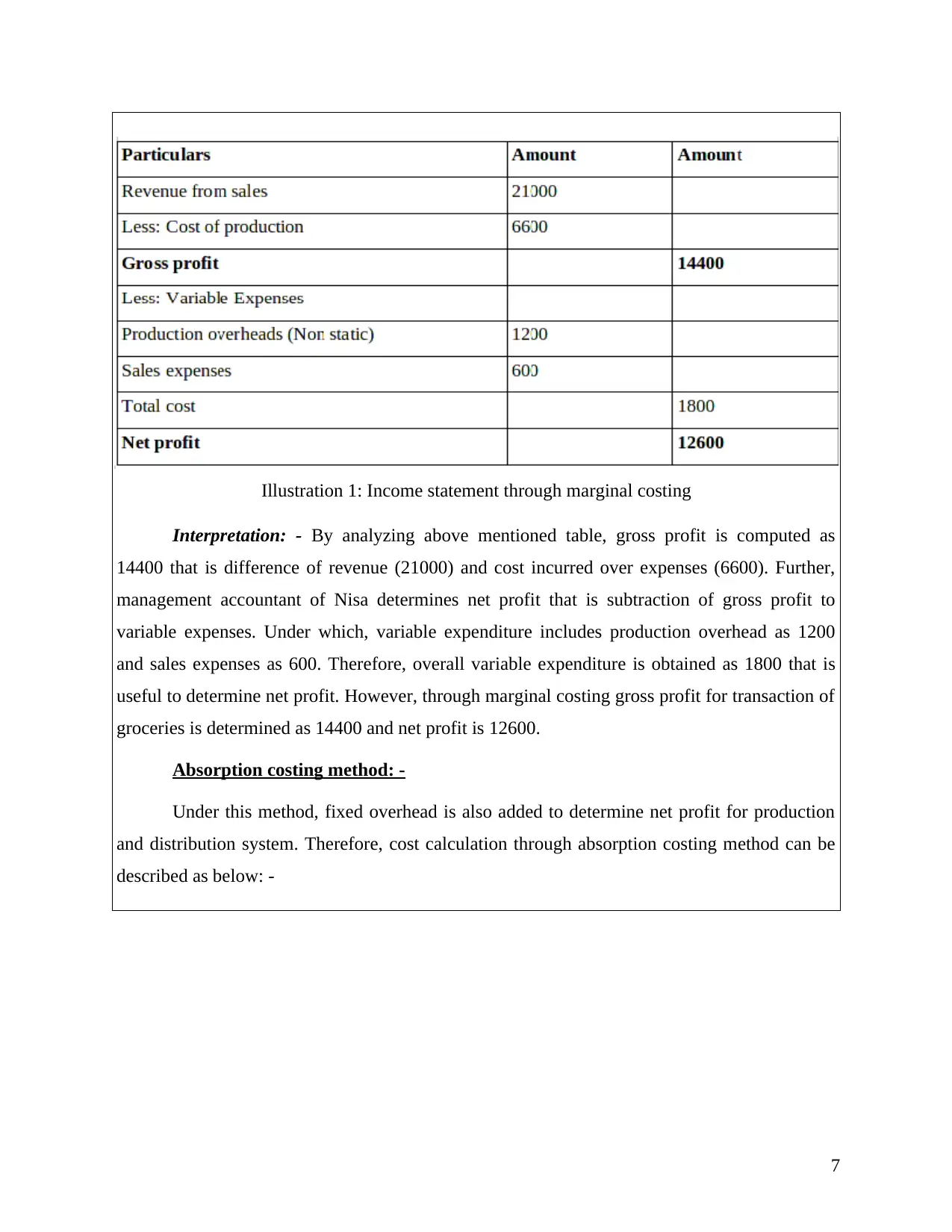
Interpretation: - By analyzing above mentioned table, gross profit is computed as
14400 that is difference of revenue (21000) and cost incurred over expenses (6600). Further,
management accountant of Nisa determines net profit that is subtraction of gross profit to
variable expenses. Under which, variable expenditure includes production overhead as 1200
and sales expenses as 600. Therefore, overall variable expenditure is obtained as 1800 that is
useful to determine net profit. However, through marginal costing gross profit for transaction of
groceries is determined as 14400 and net profit is 12600.
Absorption costing method: -
Under this method, fixed overhead is also added to determine net profit for production
and distribution system. Therefore, cost calculation through absorption costing method can be
described as below: -
7
Illustration 1: Income statement through marginal costing
14400 that is difference of revenue (21000) and cost incurred over expenses (6600). Further,
management accountant of Nisa determines net profit that is subtraction of gross profit to
variable expenses. Under which, variable expenditure includes production overhead as 1200
and sales expenses as 600. Therefore, overall variable expenditure is obtained as 1800 that is
useful to determine net profit. However, through marginal costing gross profit for transaction of
groceries is determined as 14400 and net profit is 12600.
Absorption costing method: -
Under this method, fixed overhead is also added to determine net profit for production
and distribution system. Therefore, cost calculation through absorption costing method can be
described as below: -
7
Illustration 1: Income statement through marginal costing
⊘ This is a preview!⊘
Do you want full access?
Subscribe today to unlock all pages.

Trusted by 1+ million students worldwide
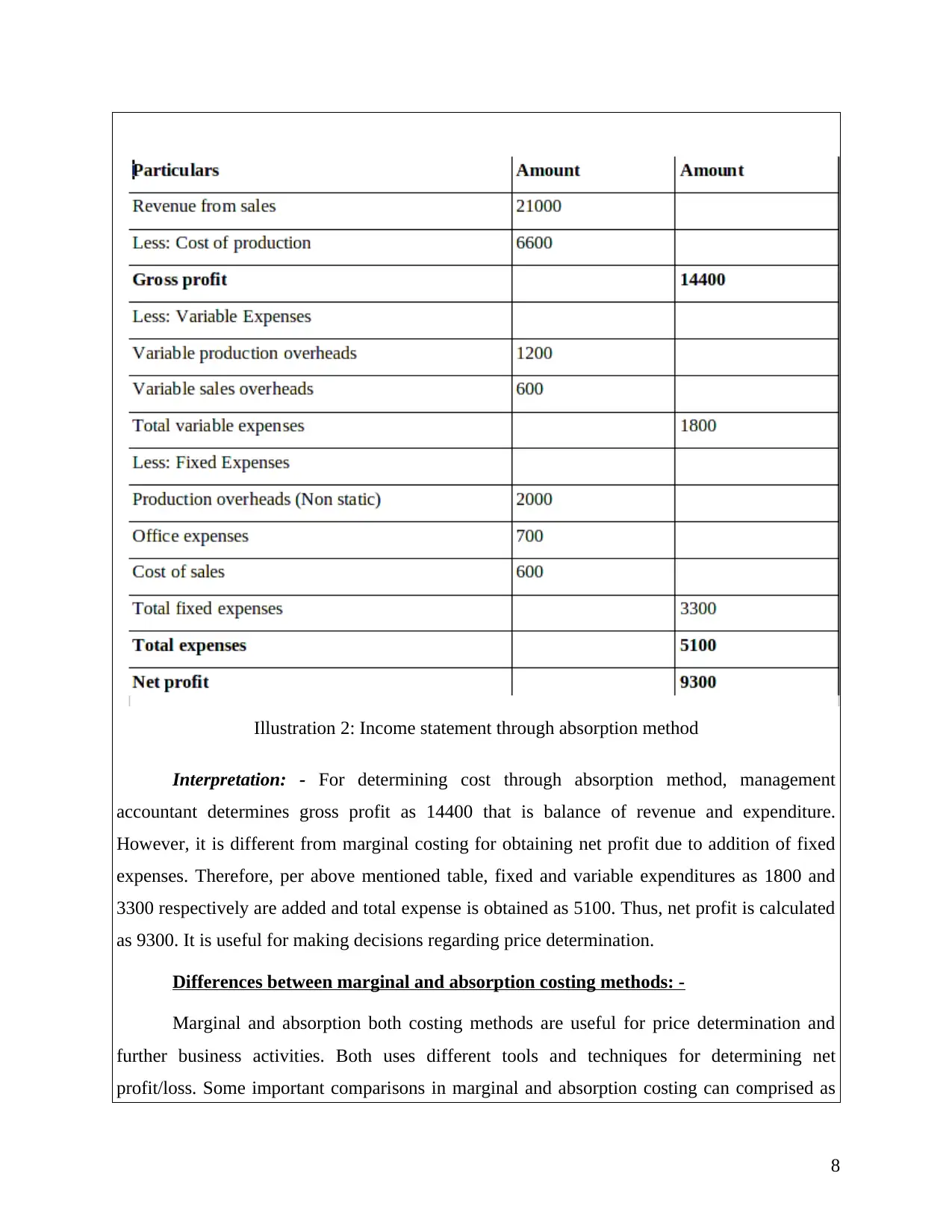
Interpretation: - For determining cost through absorption method, management
accountant determines gross profit as 14400 that is balance of revenue and expenditure.
However, it is different from marginal costing for obtaining net profit due to addition of fixed
expenses. Therefore, per above mentioned table, fixed and variable expenditures as 1800 and
3300 respectively are added and total expense is obtained as 5100. Thus, net profit is calculated
as 9300. It is useful for making decisions regarding price determination.
Differences between marginal and absorption costing methods: -
Marginal and absorption both costing methods are useful for price determination and
further business activities. Both uses different tools and techniques for determining net
profit/loss. Some important comparisons in marginal and absorption costing can comprised as
8
Illustration 2: Income statement through absorption method
accountant determines gross profit as 14400 that is balance of revenue and expenditure.
However, it is different from marginal costing for obtaining net profit due to addition of fixed
expenses. Therefore, per above mentioned table, fixed and variable expenditures as 1800 and
3300 respectively are added and total expense is obtained as 5100. Thus, net profit is calculated
as 9300. It is useful for making decisions regarding price determination.
Differences between marginal and absorption costing methods: -
Marginal and absorption both costing methods are useful for price determination and
further business activities. Both uses different tools and techniques for determining net
profit/loss. Some important comparisons in marginal and absorption costing can comprised as
8
Illustration 2: Income statement through absorption method
Paraphrase This Document
Need a fresh take? Get an instant paraphrase of this document with our AI Paraphraser
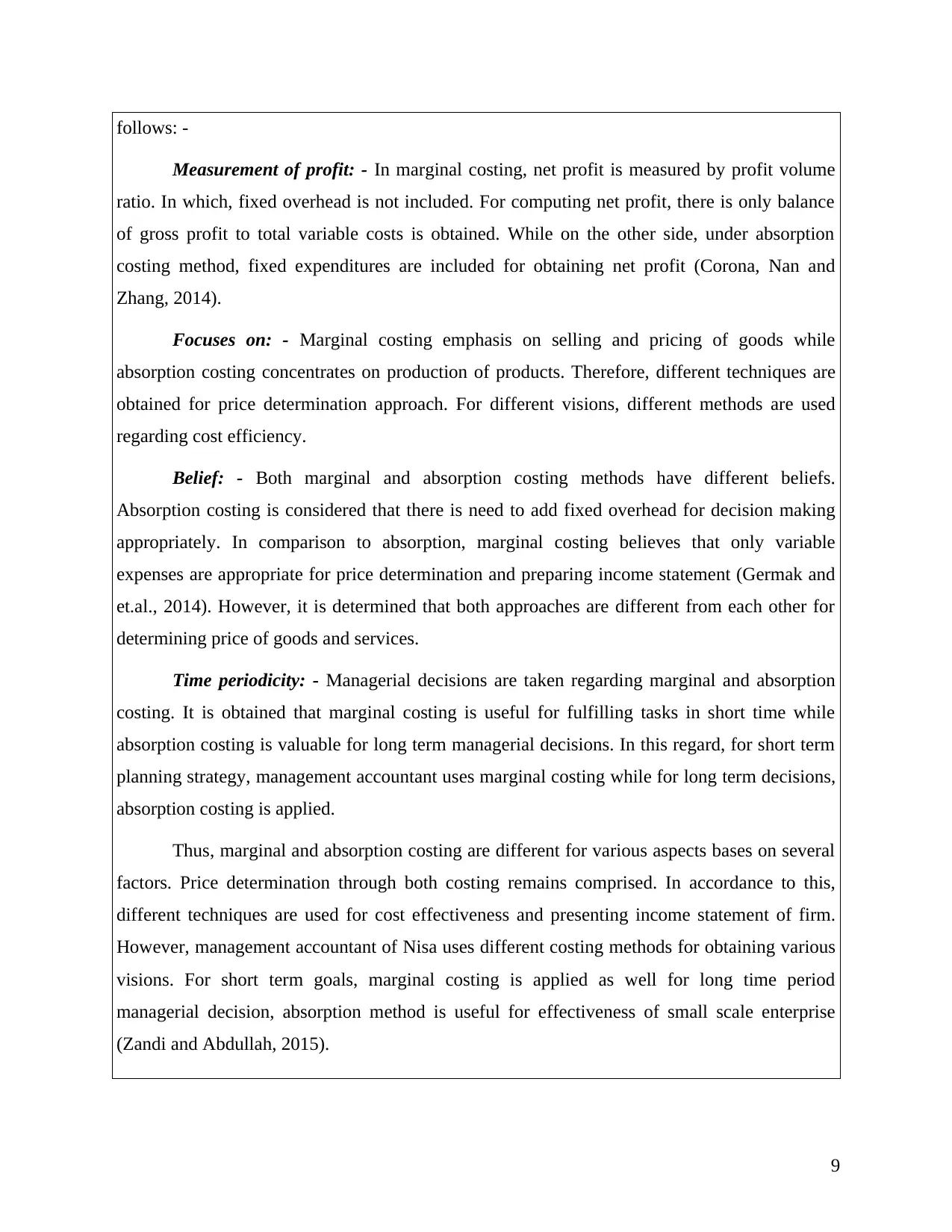
follows: -
Measurement of profit: - In marginal costing, net profit is measured by profit volume
ratio. In which, fixed overhead is not included. For computing net profit, there is only balance
of gross profit to total variable costs is obtained. While on the other side, under absorption
costing method, fixed expenditures are included for obtaining net profit (Corona, Nan and
Zhang, 2014).
Focuses on: - Marginal costing emphasis on selling and pricing of goods while
absorption costing concentrates on production of products. Therefore, different techniques are
obtained for price determination approach. For different visions, different methods are used
regarding cost efficiency.
Belief: - Both marginal and absorption costing methods have different beliefs.
Absorption costing is considered that there is need to add fixed overhead for decision making
appropriately. In comparison to absorption, marginal costing believes that only variable
expenses are appropriate for price determination and preparing income statement (Germak and
et.al., 2014). However, it is determined that both approaches are different from each other for
determining price of goods and services.
Time periodicity: - Managerial decisions are taken regarding marginal and absorption
costing. It is obtained that marginal costing is useful for fulfilling tasks in short time while
absorption costing is valuable for long term managerial decisions. In this regard, for short term
planning strategy, management accountant uses marginal costing while for long term decisions,
absorption costing is applied.
Thus, marginal and absorption costing are different for various aspects bases on several
factors. Price determination through both costing remains comprised. In accordance to this,
different techniques are used for cost effectiveness and presenting income statement of firm.
However, management accountant of Nisa uses different costing methods for obtaining various
visions. For short term goals, marginal costing is applied as well for long time period
managerial decision, absorption method is useful for effectiveness of small scale enterprise
(Zandi and Abdullah, 2015).
9
Measurement of profit: - In marginal costing, net profit is measured by profit volume
ratio. In which, fixed overhead is not included. For computing net profit, there is only balance
of gross profit to total variable costs is obtained. While on the other side, under absorption
costing method, fixed expenditures are included for obtaining net profit (Corona, Nan and
Zhang, 2014).
Focuses on: - Marginal costing emphasis on selling and pricing of goods while
absorption costing concentrates on production of products. Therefore, different techniques are
obtained for price determination approach. For different visions, different methods are used
regarding cost efficiency.
Belief: - Both marginal and absorption costing methods have different beliefs.
Absorption costing is considered that there is need to add fixed overhead for decision making
appropriately. In comparison to absorption, marginal costing believes that only variable
expenses are appropriate for price determination and preparing income statement (Germak and
et.al., 2014). However, it is determined that both approaches are different from each other for
determining price of goods and services.
Time periodicity: - Managerial decisions are taken regarding marginal and absorption
costing. It is obtained that marginal costing is useful for fulfilling tasks in short time while
absorption costing is valuable for long term managerial decisions. In this regard, for short term
planning strategy, management accountant uses marginal costing while for long term decisions,
absorption costing is applied.
Thus, marginal and absorption costing are different for various aspects bases on several
factors. Price determination through both costing remains comprised. In accordance to this,
different techniques are used for cost effectiveness and presenting income statement of firm.
However, management accountant of Nisa uses different costing methods for obtaining various
visions. For short term goals, marginal costing is applied as well for long time period
managerial decision, absorption method is useful for effectiveness of small scale enterprise
(Zandi and Abdullah, 2015).
9
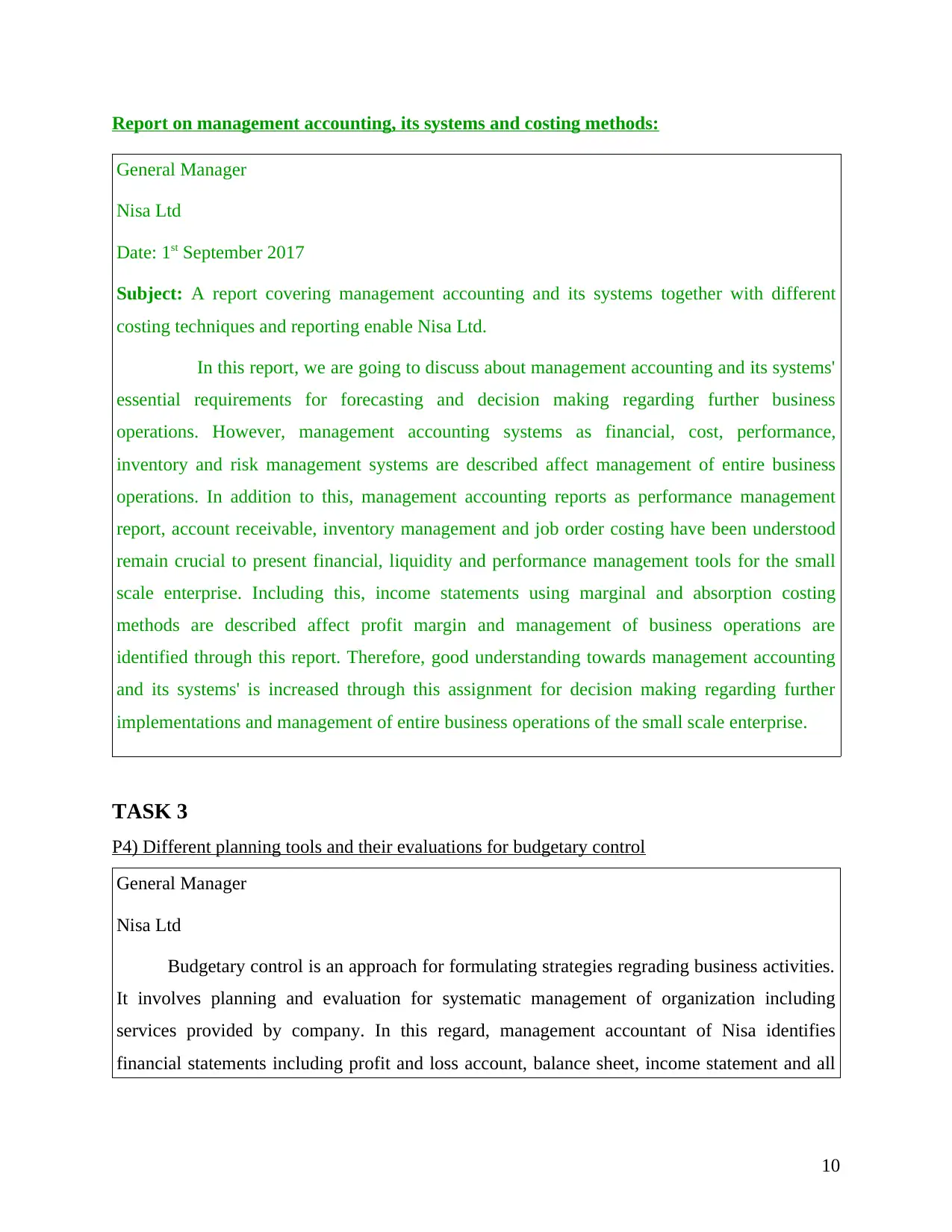
Report on management accounting, its systems and costing methods:
General Manager
Nisa Ltd
Date: 1st September 2017
Subject: A report covering management accounting and its systems together with different
costing techniques and reporting enable Nisa Ltd.
In this report, we are going to discuss about management accounting and its systems'
essential requirements for forecasting and decision making regarding further business
operations. However, management accounting systems as financial, cost, performance,
inventory and risk management systems are described affect management of entire business
operations. In addition to this, management accounting reports as performance management
report, account receivable, inventory management and job order costing have been understood
remain crucial to present financial, liquidity and performance management tools for the small
scale enterprise. Including this, income statements using marginal and absorption costing
methods are described affect profit margin and management of business operations are
identified through this report. Therefore, good understanding towards management accounting
and its systems' is increased through this assignment for decision making regarding further
implementations and management of entire business operations of the small scale enterprise.
TASK 3
P4) Different planning tools and their evaluations for budgetary control
General Manager
Nisa Ltd
Budgetary control is an approach for formulating strategies regrading business activities.
It involves planning and evaluation for systematic management of organization including
services provided by company. In this regard, management accountant of Nisa identifies
financial statements including profit and loss account, balance sheet, income statement and all
10
General Manager
Nisa Ltd
Date: 1st September 2017
Subject: A report covering management accounting and its systems together with different
costing techniques and reporting enable Nisa Ltd.
In this report, we are going to discuss about management accounting and its systems'
essential requirements for forecasting and decision making regarding further business
operations. However, management accounting systems as financial, cost, performance,
inventory and risk management systems are described affect management of entire business
operations. In addition to this, management accounting reports as performance management
report, account receivable, inventory management and job order costing have been understood
remain crucial to present financial, liquidity and performance management tools for the small
scale enterprise. Including this, income statements using marginal and absorption costing
methods are described affect profit margin and management of business operations are
identified through this report. Therefore, good understanding towards management accounting
and its systems' is increased through this assignment for decision making regarding further
implementations and management of entire business operations of the small scale enterprise.
TASK 3
P4) Different planning tools and their evaluations for budgetary control
General Manager
Nisa Ltd
Budgetary control is an approach for formulating strategies regrading business activities.
It involves planning and evaluation for systematic management of organization including
services provided by company. In this regard, management accountant of Nisa identifies
financial statements including profit and loss account, balance sheet, income statement and all
10
⊘ This is a preview!⊘
Do you want full access?
Subscribe today to unlock all pages.

Trusted by 1+ million students worldwide
1 out of 24
Related Documents
Your All-in-One AI-Powered Toolkit for Academic Success.
+13062052269
info@desklib.com
Available 24*7 on WhatsApp / Email
![[object Object]](/_next/static/media/star-bottom.7253800d.svg)
Unlock your academic potential
Copyright © 2020–2025 A2Z Services. All Rights Reserved. Developed and managed by ZUCOL.





